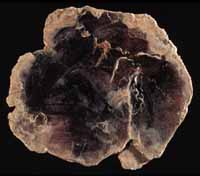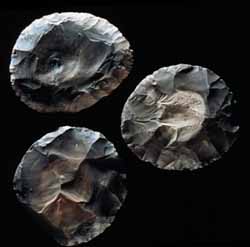
 |
Sheet of mica, Houston-Shryock site, Fulton County. | |
|
Mica, a mineral found in the southern Appalachian Mountains, was traded throughout the American Midwest. It was used to make mirrors and sometimes sheets of mica were cut into the form of animals. |
||
Because Late Archaic and Middle Woodland people traded extensively, archaeologists believe Early Woodland groups also exchanged a variety of items. But it is difficult to determine how much trade occurred during the Early Woodland sub-period because archaeologists have excavated few sites. Objects likely acquired through trade have been found at an Early Woodland site near Banner, in Fulton County, Illinois.
 |
Disks made of southern Illinois stone, Tom Collins site, Calhoun County. | |
|
Stone disks, often made of material from a distant source, have been found at sites along the Ohio, Mississippi, and Illinois rivers. In the late 1800s, more than 350 stone disks were found in a mound near Beardstown, Illinois. |
||
Trade was very important during the Middle Woodland Period. Archaeologists have found a variety of objects not available locally in Middle Woodland sites throughout Illinois. For example, at the Albany Mounds site in Whiteside County, archaeologists found sheets of mica and marine shells, neither of which are native to Illinois. Materials traded throughout Illinois include obsidian (volcanic glass) from Wyoming, copper from the upper Great Lakes, mica from the Great Smokey Mountains, grey pipestone from northern Illinois, shark teeth and marine shell from the Gulf and Atlantic coasts, and grey chert from Southern Illinois and Indiana.
For reasons archaeologists do not understand, extensive long-distance trade seems to have ended by the beginning of the Late Woodland sub-period about 1,800 years ago.
Transportation
Like their ancestors, Woodland people walked everywhere they went, except for trips along streams and rivers when they may have used dugout canoes. Regardless of season or weather, Woodland people walked to gather firewood, hunt, collect plant foods, visit neighboring villages, or to build mounds. And, objects such as obsidian and marine shell were carried to Illinois. Part of their journey may have been made in boats, but it also involved a lot of walking.
|
|
Copyright © 2000 Illinois State Museum